Nontargeted Metabolomics by High-Resolution Mass Spectrometry to Study the In Vitro Metabolism of a Dual Inverse Agonist of Estrogen-Related Receptors β and γ, DN203368
Abstract
1. Introduction
2. Materials and Methods
2.1. Chemicals and Reagents
2.2. Synthesis of DN203368 N-Oxide and N-Desisopropyl-DN203368
2.3. In Vitro Incubation of DN203368 in Liver Microsomes
2.4. Liquid Chromatography–Tandem Mass Spectrometry (LC-MS/MS)
2.5. Metabolite Identification Using the Conventional Approach
2.6. Metabolite Identification Using a Metabolomic Approach
3. Results and Discussion
3.1. DN203368 Metabolite Profiling Using the Conventional Approach
3.2. Profiling of DN203368 Metabolites Using a Metabolomic Approach
3.3. Metabolic Pathway and Interspecies Comparison
4. Conclusions
Supplementary Materials
Author Contributions
Funding
Institutional Review Board Statement
Informed Consent Statement
Data Availability Statement
Conflicts of Interest
References
- Heard, D.J.; Norby, P.L.; Holloway, J.; Vissing, H. Human ERRγ, a Third Member of the Estrogen Receptor-Related Receptor (ERR) Subfamily of Orphan Nuclear Receptors: Tissue-Specific Isoforms Are Expressed during Development and in the Adult. Mol. Endocrinol. 2000, 14, 382–392. [Google Scholar] [CrossRef] [PubMed][Green Version]
- Kim, D.K.; Kim, Y.H.; Jang, H.H.; Park, J.; Kim, J.R.; Koh, M.; Jeong, W.I.; Koo, S.H.; Park, T.S.; Yun, C.H.; et al. Estrogen-Related Receptor Gamma Controls Hepatic CB1 Receptor-Mediated CYP2E1 Expression and Oxidative Liver Injury by Alcohol. Gut 2013, 62, 1044–1054. [Google Scholar] [CrossRef]
- Kim, D.K.; Ryu, D.; Koh, M.; Lee, M.W.; Lim, D.; Kim, M.J.; Kim, Y.H.; Cho, W.J.; Lee, C.H.; Park, S.B.; et al. Orphan Nuclear Receptor Estrogen-Related Receptor Gamma (ERRgamma) is Key Regulator of Hepatic Gluconeogen-Esis. J. Biol. Chem. 2012, 287, 21628–21639. [Google Scholar] [CrossRef]
- Kim, D.K.; Kim, J.R.; Koh, M.; Kim, Y.D.; Lee, J.M.; Chanda, D.; Park, S.B.; Min, J.J.; Lee, C.H.; Park, T.S.; et al. Estrogen-Related Receptor Gamma (ERRgamma) is a Novel Transcriptional Regulator of Phosphatidic Acid Phosphatase, LIPIN1, and Inhibits Hepatic Insulin Signaling. J. Biol. Chem. 2011, 286, 38035–38042. [Google Scholar] [CrossRef]
- Eichner, L.J.; Perry, M.C.; Dufour, C.R.; Bertos, N.; Park, M.; St-Pierre, J.; Giguere, V. MiR-378(*) Mediates Metabolic Shift in Breast Cancer Cells via the PGC-1beta/ERRgamma Transcriptional Pathway. Cell Metab. 2010, 12, 352–361. [Google Scholar] [CrossRef]
- Kim, D.K.; Gang, G.T.; Ryu, D.; Koh, M.; Kim, Y.N.; Kim, S.S.; Park, J.; Kim, Y.H.; Sim, T.; Lee, I.K.; et al. Inverse Agonist of Nuclear Receptor ERRgamma Mediates Antidiabetic Effect through Inhibition of Hepatic Gluconeogenesis. Diabetes 2013, 62, 3093–3102. [Google Scholar] [CrossRef][Green Version]
- Mitsunaga, K.; Araki, K.; Mizusaki, H.; Morohashi, K.; Haruna, K.; Nakagata, N.; Giguere, V.; Yamamura, K.; Abe, K. Loss of PGC-Specific Expression of the Orphan Nuclear Receptor ERR-Beta Results in Reduction of Germ Cell Number in Mouse Embryos. Mech. Dev. 2004, 121, 237–246. [Google Scholar] [CrossRef] [PubMed]
- Festuccia, N.; Owens, N.; Navarro, P. Esrrb, an Estrogen-Related Receptor Involved in Early Development, Pluripotency, and Reprogramming. FEBS Lett. 2018, 592, 852–877. [Google Scholar] [CrossRef] [PubMed]
- Madhu Krishna, B.; Chaudhary, S.; Mishra, D.R.; Naik, S.K.; Suklabaidya, S.; Adhya, A.K.; Mishra, S.K. Estrogen Re-ceptor Alpha Dependent Regulation of Estrogen Related Receptor Beta and its Role in Cell Cycle in Breast Cancer. BMC Cancer 2018, 18, 607. [Google Scholar] [CrossRef] [PubMed]
- Kim, J.; Im, C.Y.; Yoo, E.K.; Ma, M.J.; Kim, S.B.; Hong, E.; Chin, J.; Hwang, H.; Lee, S.; Kim, N.D.; et al. Identification of Selective ERRgamma Inverse Agonists. Molecules 2016, 21, 80. [Google Scholar] [CrossRef] [PubMed]
- Singh, T.D.; Song, J.; Kim, J.; Chin, J.; Ji, H.D.; Lee, J.E.; Lee, S.B.; Yoon, H.; Yu, J.H.; Kim, S.K.; et al. A Novel Orally Active Inverse Agonist of Estrogen-related Receptor Gamma (ERRgamma), DN200434, A Booster of NIS in Anaplastic Thyroid Cancer. Clin. Cancer Res. 2019, 25, 5069–5081. [Google Scholar] [CrossRef]
- Yu, D.D.; Huss, J.M.; Li, H.; Forman, B.M. Identification of Novel Inverse Agonists of Estrogen-Related Receptors ERRγ and ERRβ. Bioorg. Med. Chem. 2017, 25, 1585–1599. [Google Scholar] [CrossRef]
- Kerns, E.H.; Di, L. Drug-Like Properties: Concepts, Structure Design and Methods from ADME to Toxicity Optimization; Elsevier: London, UK, 2008; pp. 215–223. [Google Scholar]
- Babai, S.; Auclert, L.; Le-Louët, H. Safety Data and Withdrawal of Hepatotoxic Drugs. Therapie 2018. [Google Scholar] [CrossRef]
- Manier, S.K.; Keller, A.; Schaper, J.; Meyer, M.R. Untargeted Metabolomics by High Resolution Mass Spectrometry Coupled to Normal and Reversed Phase Liquid Chromatography as a Tool to Study the In Vitro Biotransformation of New Psychoactive Substances. Sci. Rep. 2019, 9, 2741. [Google Scholar] [CrossRef]
- Lee, D.; Pagire, H.S.; Pagire, S.H.; Bae, E.J.; Dighe, M.; Kim, M.; Lee, K.M.; Jang, Y.K.; Jaladi, A.K.; Jung, K.-Y.; et al. Discovery of Novel Pyruvate Dehydrogenase Kinase 4 Inhibitors for Potential Oral Treatment of Metabolic Diseases. J. Med. Chem. 2019, 62, 575–588. [Google Scholar] [CrossRef]
- Joo, J.; Wu, Z.; Lee, B.; Shon, J.C.; Lee, T.; Lee, I.K.; Sim, T.; Kim, K.H.; Kim, N.D.; Kim, S.H.; et al. In Vitro Metabolism of an Estrogen-Related Receptor Gamma Modulator, GSK5182, by Human Liver Microsomes and Recombinant Cyto-Chrome P450s. Biopharm. Drug Dispos. 2015, 36, 163–173. [Google Scholar] [CrossRef]
- Zhou, Z.M.; Wang, Y.K.; Yan, D.M.; Fang, J.H.; Xiao, X.R.; Zhang, T.; Cheng, Y.; Xu, K.P.; Li, F. Metabolic Pro fi Ling of Tyrosine Kinase Inhibitor Nintedanib using Metabolomics. J. Pharm. Biomed. Anal. 2020, 180, 113045. [Google Scholar] [CrossRef]
- Fang, Z.Z.; Krausz, K.W.; Li, F.; Cheng, J.; Tanaka, N.; Gonzalez, F.J. Metabolic Map and Bioactivation of the Anti-Tumour Drug Noscapine. Br. J. Pharmacol. 2012, 167, 1271–1286. [Google Scholar] [CrossRef]
- Xie, C.; Gao, X.; Sun, D.; Zhang, Y.; Krausz, K.W.; Qin, X.; Gonzalez, F.J. Metabolic Profiling of the Novel Hypox-ia-Inducible Factor 2alpha Inhibitor PT2385 In Vivo and In Vitro. Drug Metab. Dispos. 2018, 46, 336–345. [Google Scholar] [CrossRef]
- Coward, P.; Lee, D.; Hull, M.V.; Lehmann, J.M. 4-Hydroxytamoxifen Binds to and Deactivates the Estrogen-Related Receptor Gamma. Proc. Natl. Acad. Sci. USA 2001, 98, 8880–8884. [Google Scholar] [CrossRef]
- Mangla, B.; Alam, O.; Rub, R.R.; Iqbal, M.; Singh, A.; Patel, K.S.; Kohli, K. Development and Validation of a High Throughput Bioanalytical UPLC-MS/MS Method for Simultaneous Determination of Tamoxifen and Sulfphoraphane in Rat Plasma: Application to an Oral Pharmacokinetic Study. J. Chromatogr. B Analyt. Technol. Biomed. Life Sci. 2020, 1152, 122260. [Google Scholar] [CrossRef] [PubMed]
- Merel, S.; Lege, S.; Heras, J.E.Y.; Zwiener, C. Assessment of N-Oxide Formation during Wastewater Ozonation. Environ. Sci. Technol. 2016, 51, 410–417. [Google Scholar] [CrossRef] [PubMed]
- Christopher, L.J.; Cui, D.; Li, W.; Barros, A.; Arora, V.K.; Zhang, H.; Wang, L.; Zhang, N.; Manning, J.A.; He, K.; et al. Biotransformation of [14C]Dasatinib: In Vitro Studies in Rat, Monkey, and Human and Disposition after Administration to Rats and Monkeys. Drug Metab. Dispos. 2008, 36, 1341–1356. [Google Scholar] [CrossRef]
- Chen, C.; Gonzalez, F.J.; Idle, J.R. LC-MS-Based Metabolomics in Drug Metabolism. Drug Metab. Rev. 2007, 39, 581–597. [Google Scholar] [CrossRef]
- Fang, Z.-Z.; Gonzalez, F.J. LC-MS-Based Metabolomics: An Update. Arch. Toxicol. 2014, 88, 1491–1502. [Google Scholar] [CrossRef]
- Kim, J.H.; Choi, W.G.; Moon, J.Y.; Lee, J.Y.; Lee, S.; Lee, H.S. Metabolomics-Assisted Metabolite Profiling of Itracona-Zole in Human Liver Preparations. J. Chromatogr. B Analyt. Technol. Biomed. Life Sci. 2018, 1083, 68–74. [Google Scholar] [CrossRef] [PubMed]
- Li, Y.; Wu, L.; Gu, Y.; Si, D.; Liu, C. Metabolism of Aildenafil In Vivo in Rats and In Vitro in Mouse, Rat, Dog, and Human Liver Microsomes. Drug Test Anal. 2014, 6, 552–562. [Google Scholar] [CrossRef]
- Dehal, S.S.; Kupfer, D. Evidence that the Catechol 3,4-Dihydroxytamoxifen is a Proximate Intermediate to the Reactive Species Binding Covalently to Proteins. Cancer Res. 1996, 56, 1283–1290. [Google Scholar]
- Yao, D.; Zhang, F.; Yu, L.; Yang, Y.; van Breemen, R.B.; Bolton, J.L. Synthesis and Reactivity of Potential Toxic Metabo-lites of Tamoxifen Analogues: Droloxifene and Toremifene o-Quinones. Chem. Res. Toxicol. 2001, 14, 1643–1653. [Google Scholar] [CrossRef]
- Liu, X.; Pisha, E.; Tonetti, D.A.; Yao, D.; Li, Y.; Yao, J.; Burdette, J.E.; Bolton, J.L. Antiestrogenic and DNA Damaging Effects Induced by Tamoxifen and Toremifene Metabolites. Chem. Res. Toxicol. 2003, 16, 832–837. [Google Scholar] [CrossRef] [PubMed]
- Chowdhury, G.; Shibata, N.; Yamazaki, H.; Guengerich, F.P. Human Cytochrome P450 Oxidation of 5-Hydroxythalidomide and Pomalidomide, an Amino Analogue of Thalidomide. Chem. Res. Toxicol. 2014, 27, 147–156. [Google Scholar] [CrossRef] [PubMed]
- Burczynski, E.M.; Penning, T. Genotoxic Polycyclic Aromatic Hydrocarbon Ortho-Quinones Generated by Aldo-Keto Reductases Induce CYP1A1 via Nuclear Translocation of the Aryl Hydrocarbon Receptor. Cancer Res. 2000, 60, 908–915. [Google Scholar] [PubMed]
- Chi, M.; Peng, Y.; Zheng, J. Characterization of Glutathione Conjugates Derived from Reactive Metabolites of Bakuchiol. Chem. Interact. 2016, 244, 178–186. [Google Scholar] [CrossRef] [PubMed]
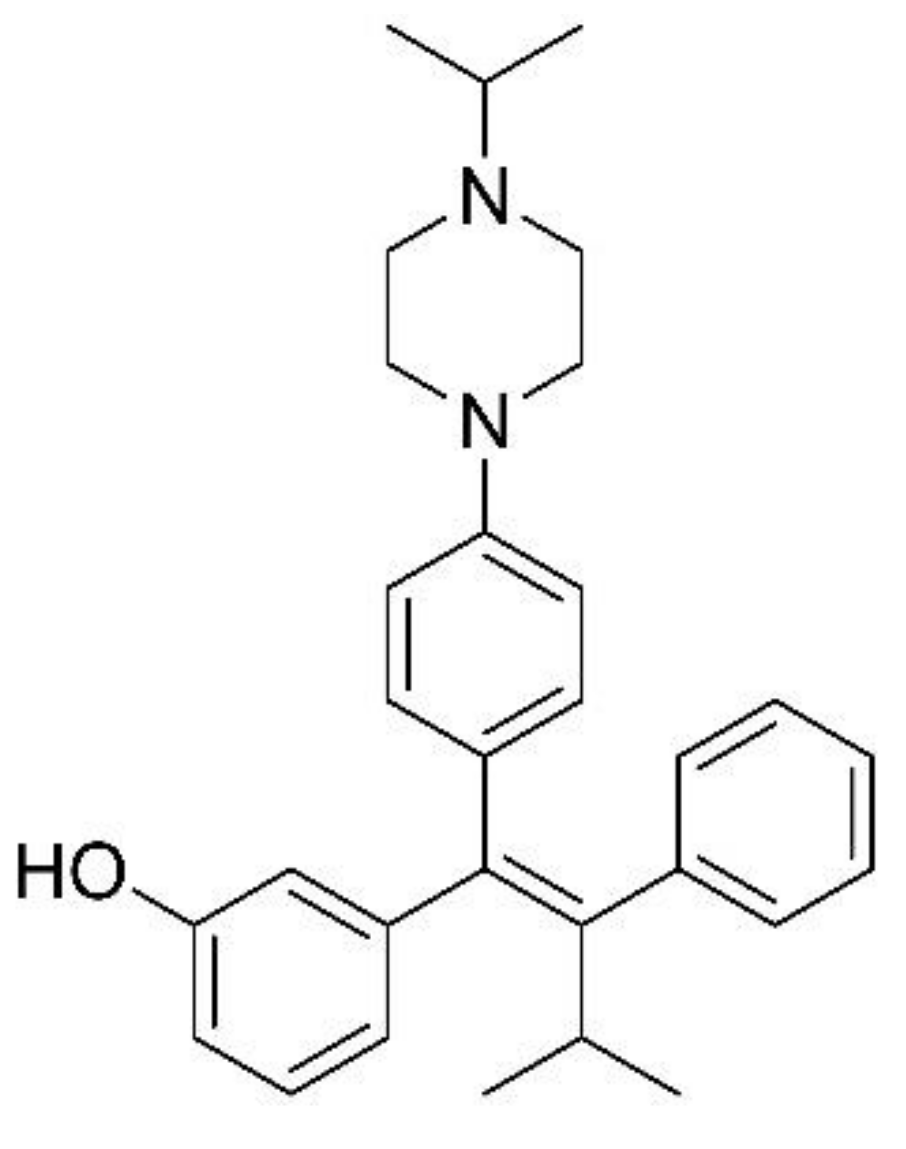
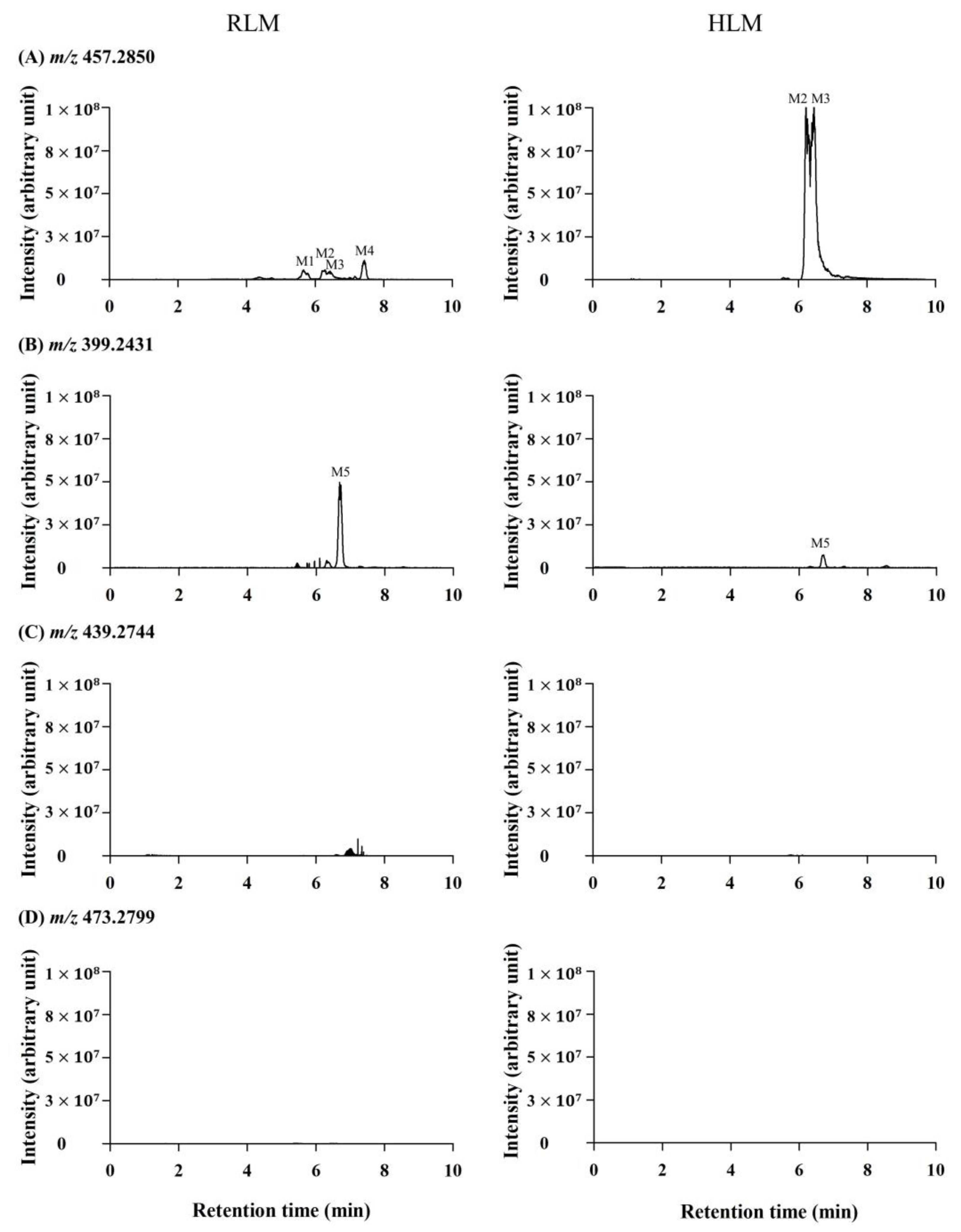
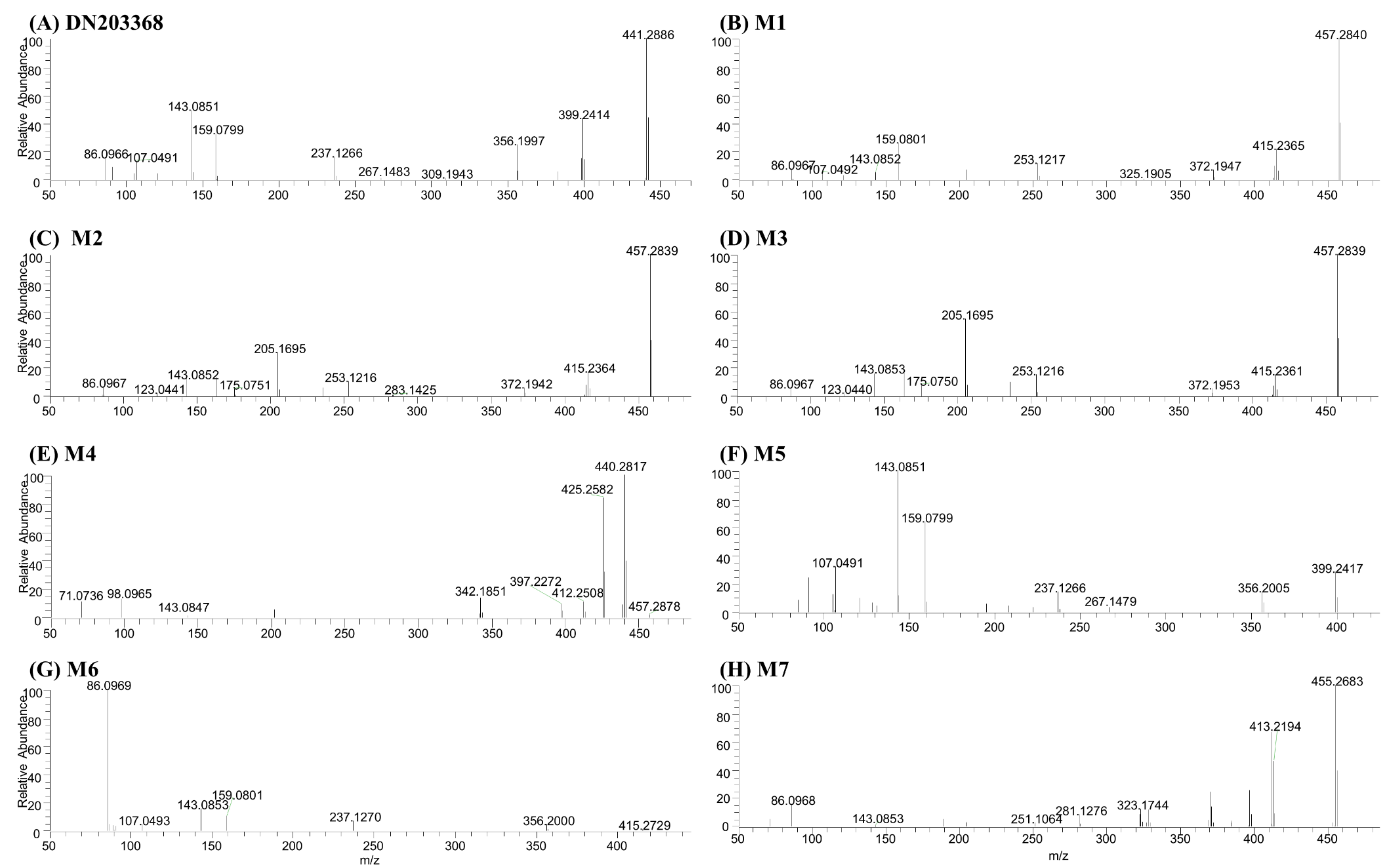

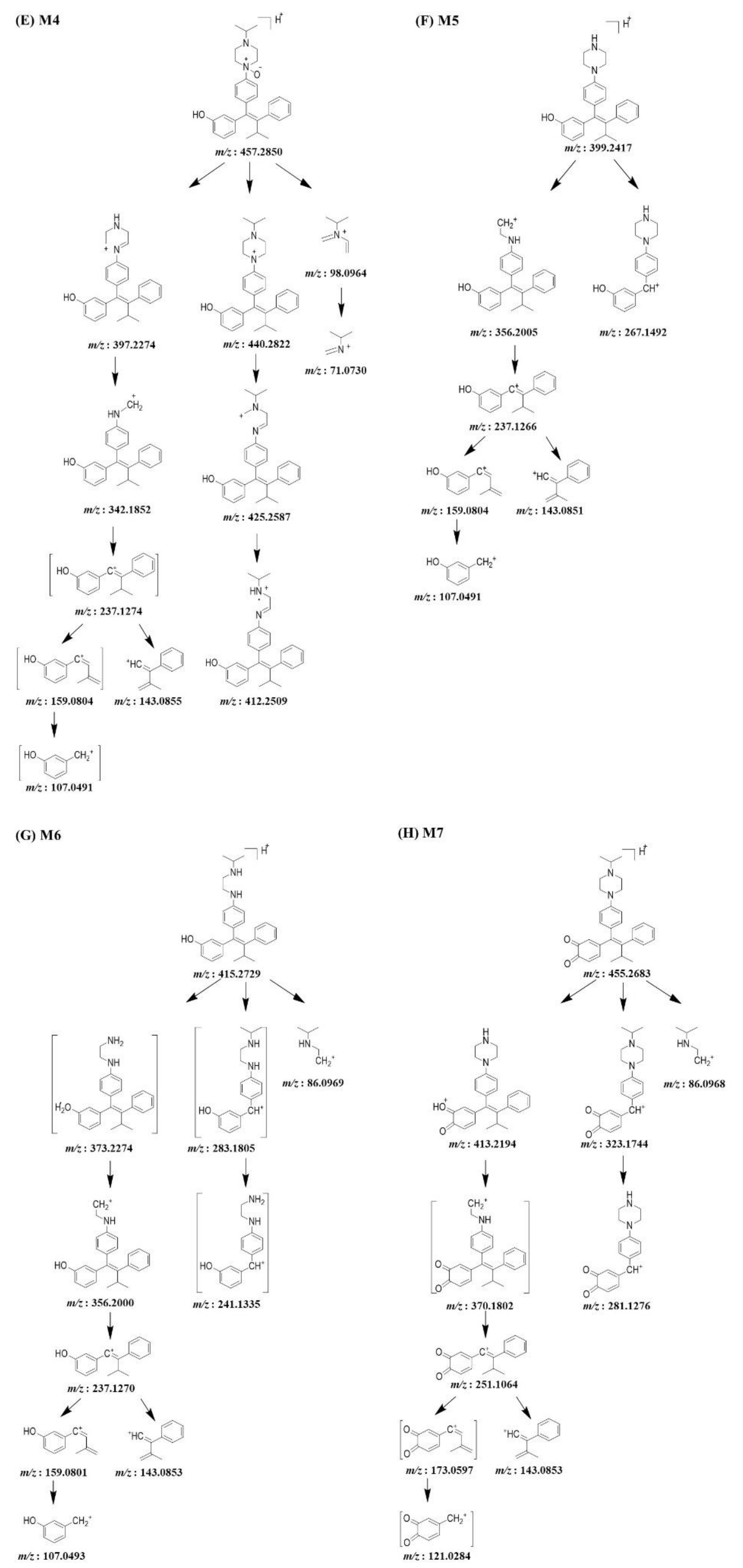
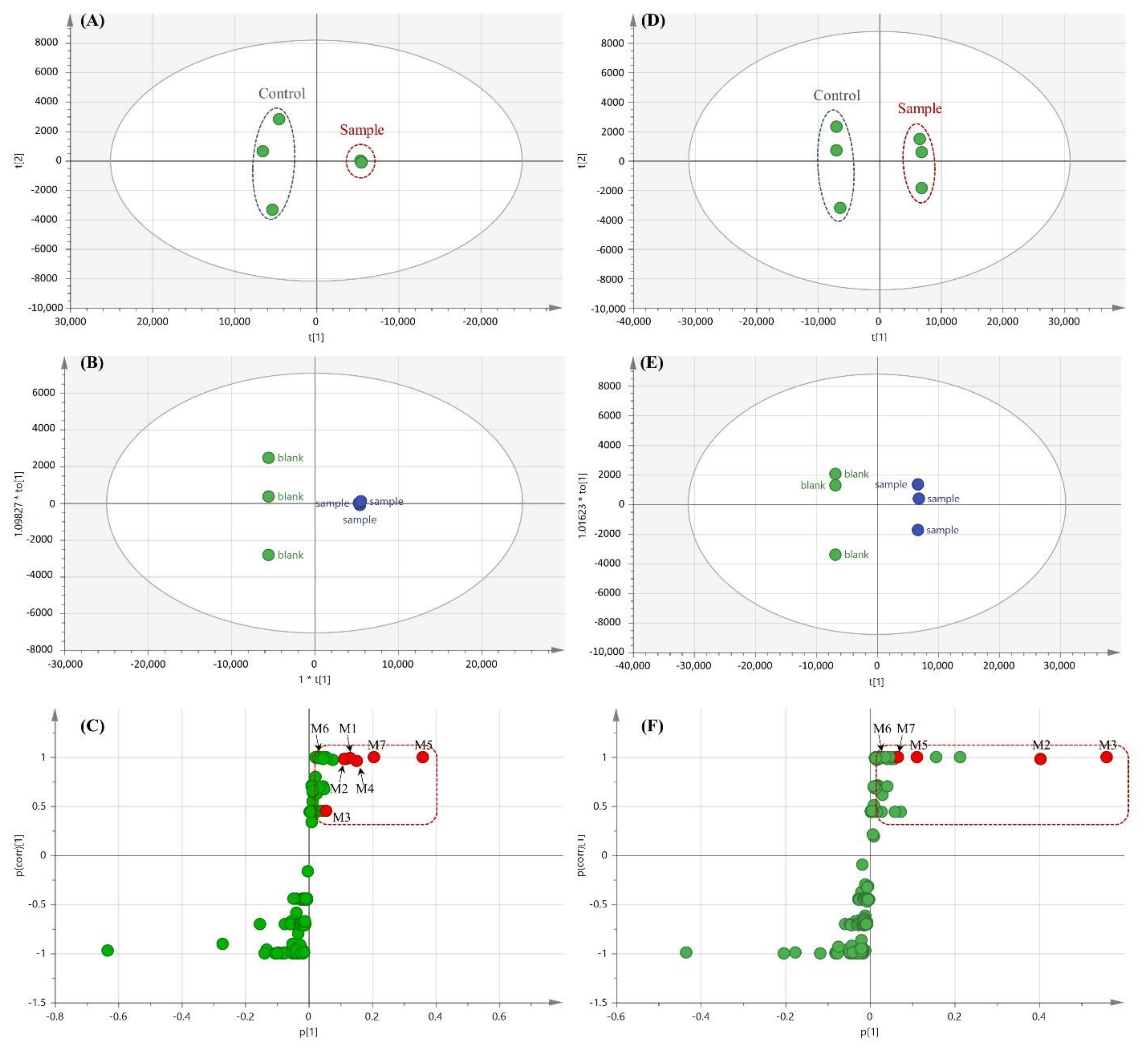

| No. | Assignment | tR (min) | [M+H]+ | Error (ppm) | Formula (Neutral) | Conventional Method | Metabolomic Approach | |||
|---|---|---|---|---|---|---|---|---|---|---|
| Measured | Theoretical | RLMs | HLMs | RLMs | HLMs | |||||
| M0 | DN203368 | 7.28 | 441.2886 | 441.2900 | −3.17 | C30H36N2O | ||||
| M1 | Hydroxylation | 5.69 | 457.2840 | 457.2850 | −2.19 | C30H36N2O2 | ++ | ++ | ||
| M2 | Hydroxylation | 6.21 | 457.2839 | 457.2850 | −2.41 | C30H36N2O2 | ++ | +++ | ++ | +++ |
| M3 | Hydroxylation | 6.42 | 457.2839 | 457.2850 | −2.41 | C30H36N2O2 | ++ | +++ | ++ | +++ |
| M4 | N-Oxidation | 7.46 | 457.2863 | 457.2850 | 2.84 | C30H36N2O2 | ++ | ++ | ||
| M5 | N-Deisopropylation | 6.73 | 399.2417 | 399.2431 | −3.51 | C27H30N2O | ++ | ++ | ++ | ++ |
| M6 | N-Dealkylation | 7.18 | 415.2729 | 415.2744 | −3.61 | C28H34N2O | + | + | ||
| M7 | Hydroxylation, Dehydrogenation | 7.01 | 455.2683 | 455.2693 | −2.20 | C30H34N2O2 | ++ | ++ | ||
Publisher’s Note: MDPI stays neutral with regard to jurisdictional claims in published maps and institutional affiliations. |
© 2021 by the authors. Licensee MDPI, Basel, Switzerland. This article is an open access article distributed under the terms and conditions of the Creative Commons Attribution (CC BY) license (https://creativecommons.org/licenses/by/4.0/).
Share and Cite
Kim, S.-E.; Ji, S.-B.; Kim, E.; Jeong, M.; Kim, J.; Lee, G.-M.; Seo, H.-J.; Bae, S.; Jeong, Y.; Lee, S.; et al. Nontargeted Metabolomics by High-Resolution Mass Spectrometry to Study the In Vitro Metabolism of a Dual Inverse Agonist of Estrogen-Related Receptors β and γ, DN203368. Pharmaceutics 2021, 13, 776. https://doi.org/10.3390/pharmaceutics13060776
Kim S-E, Ji S-B, Kim E, Jeong M, Kim J, Lee G-M, Seo H-J, Bae S, Jeong Y, Lee S, et al. Nontargeted Metabolomics by High-Resolution Mass Spectrometry to Study the In Vitro Metabolism of a Dual Inverse Agonist of Estrogen-Related Receptors β and γ, DN203368. Pharmaceutics. 2021; 13(6):776. https://doi.org/10.3390/pharmaceutics13060776
Chicago/Turabian StyleKim, Sin-Eun, Seung-Bae Ji, Euihyeon Kim, Minseon Jeong, Jina Kim, Gyung-Min Lee, Hyung-Ju Seo, Subin Bae, Yeojin Jeong, Sangkyu Lee, and et al. 2021. "Nontargeted Metabolomics by High-Resolution Mass Spectrometry to Study the In Vitro Metabolism of a Dual Inverse Agonist of Estrogen-Related Receptors β and γ, DN203368" Pharmaceutics 13, no. 6: 776. https://doi.org/10.3390/pharmaceutics13060776
APA StyleKim, S.-E., Ji, S.-B., Kim, E., Jeong, M., Kim, J., Lee, G.-M., Seo, H.-J., Bae, S., Jeong, Y., Lee, S., Kim, S., Lee, T., Cho, S. J., & Liu, K.-H. (2021). Nontargeted Metabolomics by High-Resolution Mass Spectrometry to Study the In Vitro Metabolism of a Dual Inverse Agonist of Estrogen-Related Receptors β and γ, DN203368. Pharmaceutics, 13(6), 776. https://doi.org/10.3390/pharmaceutics13060776







